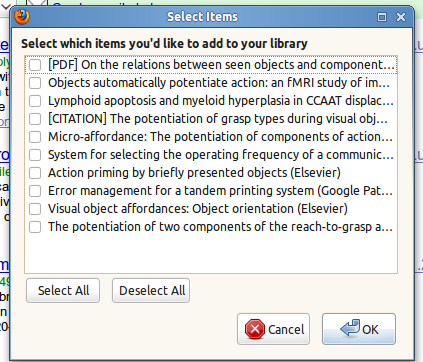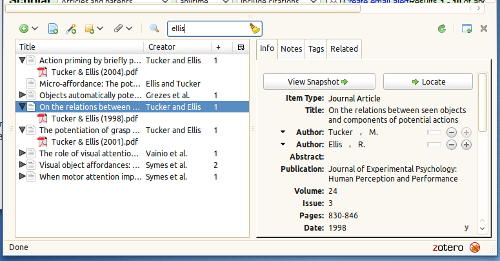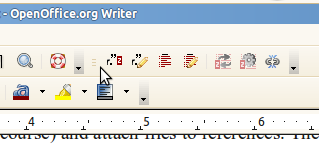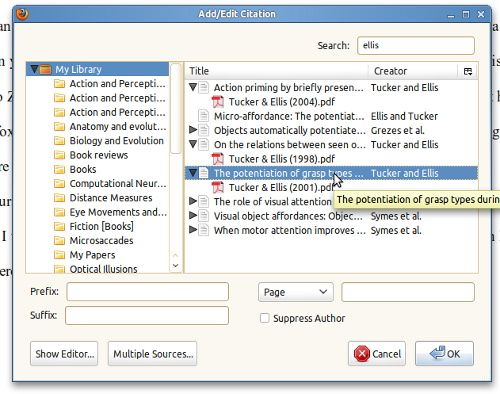Update Nov 16, 2010: If you have trouble getting Zotero/ OpenOffice to work on Linux, please see this post.
If you've ever written a paper or a thesis you will no doubt agree that reference management can be a daunting task. You have to make sure that every reference in the text appears in the reference list, and, conversely, that every item from the reference list actually appears in the text. There are also many style guidelines that you're supposed to adhere to.
For example, according to the publication manual of the American Psychological Association (APA), the first time that you cite a paper you have to list all authors (unless there are more than five authors), like “(Author1, Author2, & Author3, 2010)”. In subsequent citations, you should name only the first author, like “(Author1 et al., 2010)”. In itself, this is a sensible rule, but it means that you have to keep track of where in the text you cite a paper for the first time. This also means that you have to update your citations whenever you shuffle around paragraphs. These are precisely the types of trivialities that you do not want to bother with while writing a manuscript!
Fortunately, there are software packages available that help you manage your references. The most famous of these are BibTeX (which is actually a format used by multiple tools), EndNote (widely used, but proprietary) and Zotero. If you want to cite a paper, you simply tell the reference manager to insert a citation somewhere in your manuscript (this, of course, requires integration with your word processor) and a properly formatted citation magically appears. A reference list is also generated automatically. Nice!
In this post I will focus on Zotero, which is a free and open source reference manager. I have used Zotero on a daily basis for almost two years now and I have grown to depend on it. Zotero is not a standalone program, but it consists of two plugins for the Firefox internet browser. The first plugin is the actual reference manager. The second plugin provides integration with your word processor. Open Office and Microsoft Word are supported. Once you have installed Zotero and do a search on Google Scholar (this also works on most other scientific websites) a small icon appears in your navigation bar (Figure 1). If you click this item, a dialog pops up, which asks you to select the item that you want to import into Zotero (Figure 2).

Figure 1. You can import references by clicking on the "Save to Zotero" button.

Figure 2. If a page contains multiple references, which is the case with Google Scholar, you need to specify which item you want to import.
In order to open the main Zotero interface, you click on the Zotero icon at the bottom-right of your Firefox window (Figure 3).

Figure 3. The main Zotero interface, which appears if you click on the Zotero icon in the bottom-right of your Firefox window.
In the main Zotero interface, you can modify references, manually add new references (importing references through a website is much more efficient, though) and attach files to references. The fact that you can attach files to references is very convenient, because it allows you to save the actual PDF files within your reference manager! You might also want to take a look at Gnotero, which is my own sidekick to Zotero (Figure 4). With Gnotero you can quickly search and open your references, without having to open Firefox. This saves some time, because in my experience the Zotero plugin is a bit sluggish.

Figure 4. Gnotero provides easy access to your Zotero references.
Of course, the really useful aspect of a reference manager is the integration with your word processor. Zotero appears in Open Office as a collection of buttons in the toolbar (Figure 5). Integration with Microsoft Word works similarly.

Figure 5. Zotero appears as a collection of toolbar buttons in your word processor.
If you click on the “add citation” button, a dialog appears, in which you can select a reference (Figure 6). The first time that you add a citation, you also need to specify the style that you want to use (for this example I used the APA style) and whether you wish to use ReferenceMarks or Bookmarks. The latter option is slightly technical. If you select BookMarks, you can save your document in Microsoft Word (.doc) format. If you select ReferenceMarks you must save your document in Open Document (.odt) format. In my experience, ReferenceMarks is the preferred option, because there are some stability issues with BookMarks (although these may have been resolved by now).

Figure 6. Adding a citation to your manuscript in your word processor.
The citation appears as a gray field in your manuscript (Figure 7). A reference list can also be generated automatically.

Figure 7. A citation (gray) and reference list, as they appear in the word processor.
Pros and cons
Pros
- Zotero is free and open source.
- Development on Zotero is very active and there is a large and friendly community of Zotero users.
- You can use Zotero to store PDFs.
- Zotero is available for all platforms.
Cons
- The Zotero interface is a bit sluggish. If you need quicker access to your Zotero references, take a look at Gnotero.
- Zotero requires Firefox. Although Firefox is a nice browser, it would have been nice if Zotero could be used with other browsers as well.
- Zotero does not handle all types of references gracefully. For example, you will manually need to modify the way that “in press” papers and book chapters are cited, at least when using the APA style.
- In the past, I have experienced some stability issues with Zotero, especially when using BookMarks in Open Office. In all fairness, Zotero's stability has greatly improved over the last few releases and I hardly experience any issues anymore.
In summary, I would definitely recommend Zotero to anyone who is looking for a good reference manager!



